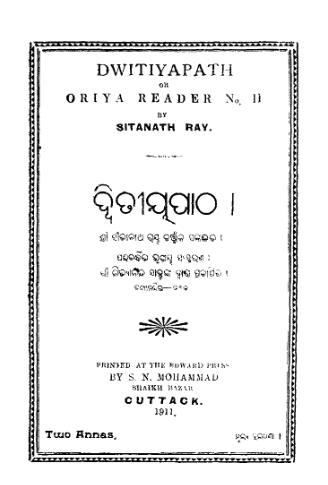Published in 1911, Dwitiya Patha, edited by Sita Natha Ray, stands as a significant textbook in the landscape of early 20th-century Indian education. This work reflects the educational ethos of its time, emphasizing not only the curriculum but also the cultural and moral values that were deemed essential for students.
In the early 1900s, India was undergoing transformative changes under British colonial rule. The emergence of nationalist sentiments, along with a push for modern education, influenced the development of textbooks. Dwitiya Patha was conceived during this pivotal time, aiming to provide students with knowledge that was both relevant and foundational. Sita Natha Ray, a prominent educator and reformer, sought to bridge traditional Indian learning with modern educational practices, creating a text that would resonate with students across various backgrounds.
Dwitiya Patha is structured to cater to the needs of learners at the intermediate level, blending language, literature, and moral instruction. The textbook is rich in content, featuring a variety of subjects that include regional folklore, historical narratives, and the sciences, all presented in a manner accessible to young minds. This multidisciplinary approach not only nurtured intellectual growth but also encouraged students to appreciate their cultural heritage.
The emphasis on moral education is particularly noteworthy. Ray understood that knowledge alone was insufficient; character building was equally important. As such, Dwitiya Patha includes stories and parables that reinforce ethical values, promoting virtues such as honesty, empathy, and social responsibility. This holistic approach aimed at producing well-rounded individuals who could contribute positively to society.
Ray’s editing style in Dwitiya Patha is characterized by clarity and simplicity, making complex concepts comprehensible for students. The language employed is both engaging and instructive, appealing to the sensibilities of young learners while fostering a love for reading and literature. Poetic excerpts, anecdotes, and illustrations enrich the text, allowing students to immerse themselves in diverse discourses.
The selection of literature within the textbook reflects the wider Indian literary tradition, connecting students with the rich tapestry of their heritage. From folk tales to classical poetry, Ray curated a collection that aimed to instill a sense of pride and identity among learners.
The impact of Dwitiya Patha extends beyond its immediate educational role; it played a crucial part in shaping the discourse around educational reform in India. By prioritizing a curriculum that was inclusive and morally grounded, Sita Natha Ray contributed to the broader movement that sought to empower Indian youth through education.
Furthermore, Dwitiya Patha serves as a historical document, providing insight into the pedagogical strategies and cultural values of its time. As modern educators continue to explore ways to integrate traditional wisdom with contemporary practices, Ray’s work remains a valuable reference point.
Books Info
| Books name | Dwitiya Patha / ଦ୍ଵିତୀୟ ପାଠ |
| Author | Sita Natha Ray, Ed. |
| No Of pages | 48 |
| Publisher | NA |
| Publication | 1911 |
| Printed At | The Edward Press |
| Distributor | NA |

